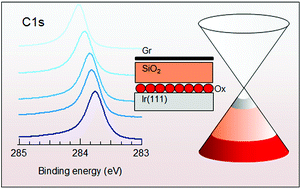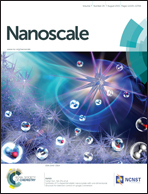Chemical gating of epitaxial graphene through ultrathin oxide layers†
Abstract
We achieved a controllable chemical gating of epitaxial graphene grown on metal substrates by exploiting the electrostatic polarization of ultrathin SiO2 layers synthesized below it. Intercalated oxygen diffusing through the SiO2 layer modifies the metal–oxide work function and hole dopes graphene. The graphene/oxide/metal heterostructure behaves as a gated plane capacitor with the in situ grown SiO2 layer acting as a homogeneous dielectric spacer, whose high capacity allows the Fermi level of graphene to be shifted by a few hundreds of meV when the oxygen coverage at the metal substrate is of the order of 0.5 monolayers. The hole doping can be finely tuned by controlling the amount of interfacial oxygen, as well as by adjusting the thickness of the oxide layer. After complete thermal desorption of oxygen the intrinsic doping of SiO2 supported graphene is evaluated in the absence of contaminants and adventitious adsorbates. The demonstration that the charge state of graphene can be changed by chemically modifying the buried oxide/metal interface hints at the possibility of tuning the level and sign of doping by the use of other intercalants capable of diffusing through the ultrathin porous dielectric and reach the interface with the metal.


 Please wait while we load your content...
Please wait while we load your content...